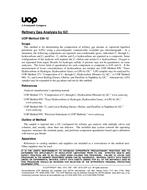We need your consent to use the individual data so that you can see information about your interests, among other things. Click "OK" to give your consent.
UOP 539-12
Refinery Gas Analysis by GC
Automatically translated name:
Refinery Gas Analysis by Gas Chromatography
STANDARD published on 1.8.2012
The information about the standard:
Designation standards: UOP 539-12
Publication date standards: 1.8.2012
SKU: NS-574800
The number of pages: 7
Approximate weight : 21 g (0.05 lbs)
Country: American technical standard
Category: Technical standards UOP
Preview of the standard UOP 539-12
| 1. Scope |
|
This method is for determining the composition of refinery gas streams or vaporized liquefied petroleum gas (LPG) using a preconfigured, commercially available gas chromatograph. At a minimum, the following components are reported: non-condensable gases, individual C1 through C4 hydrocarbons and C5 paraffins. C5 olefins and C6+ hydrocarbons are reported as a composite. Some configurations of the analyzer will separate the C5 olefins and certain C6+ hydrocarbons. Oxygen is not separated from argon. Results for hydrogen sulfide, if present, may not be quantitative on some analyzers. The lower limit of quantitation for each component or composite is 0.05 mol-%. If the measurement of lower concentrations of hydrocarbons are needed, use UOP Method 899, “Trace Hydrocarbons in Hydrogen, Hydrocarbon Gases, or LPG by GC.” LPG samples may be analyzed by UOP Method 373, “Composition of C2 through C5 Hydrocarbon Mixtures by GC,” or UOP Method 980, “C5 and Lower Boiling Dienes, Olefins, and Paraffins in Naphthas by GC.” Alternatively, LPG samples may be expanded to the gas phase and run by this method. |
We recommend:
Technical standards updating
Do you want to make sure you use only the valid technical standards?
We can offer you a solution which will provide you a monthly overview concerning the updating of standards which you use.
Would you like to know more? Look at this page.




 Cookies
Cookies
